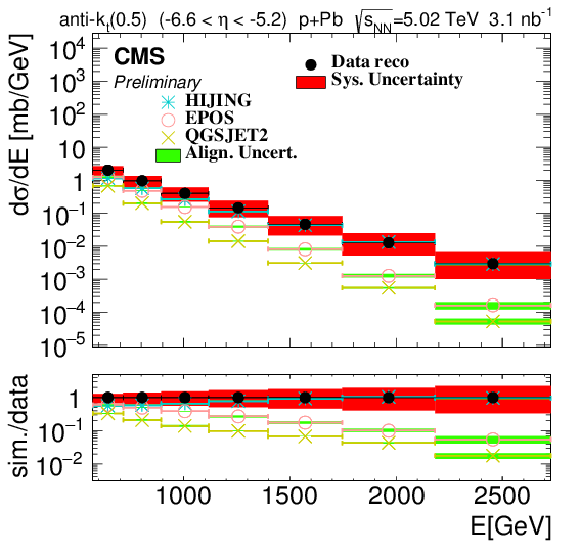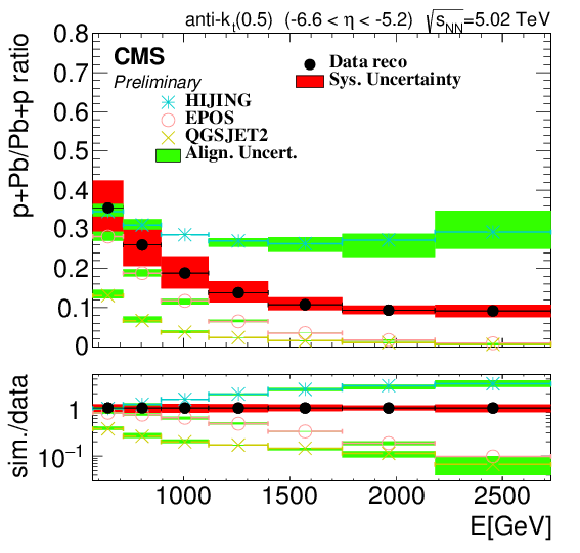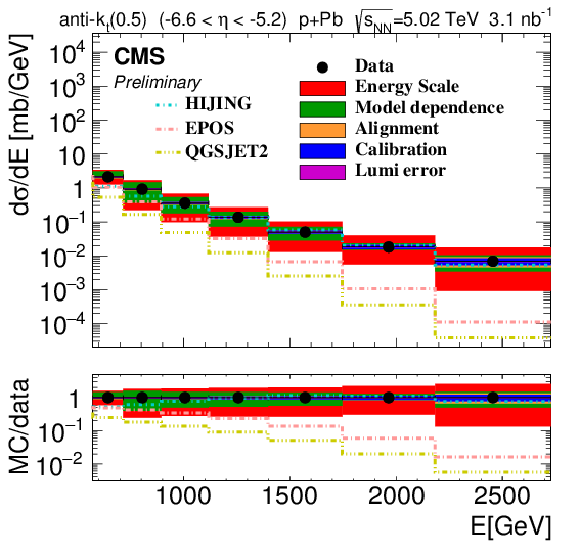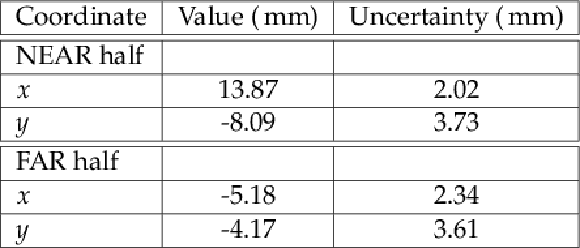

Compact Muon Solenoid
LHC, CERN
| CMS-PAS-FSQ-17-001 | ||
| Very forward inclusive jet cross sections in p+Pb collisions at √sNN= 5.02 TeV | ||
| CMS Collaboration | ||
| April 2017 | ||
| Abstract: Measurements of very forward inclusive jet energy spectra with the CMS experiment at the LHC are presented. The data were collected with the CASTOR calorimeter in the pseudorapidity range −6.6<η<−5.2 in proton lead collisions, with a centre-of-mass energy of √sNN= 5.02 TeV in 2013. The analysed data samples correspond to integrated luminosities of 3.13 and 6.71 nb−1, for beam configurations with the proton (p+Pb) or ion (Pb+p) towards CASTOR, respectively. The results are presented for energy ranges from 600 to 2500 (p+Pb) and 4000 (Pb+p) GeV. The spectra are unfolded to the particle level and compared to predictions of various event generators. In addition, the p+Pb/Pb+p ratio of the spectra is presented, for which the systematic uncertainties in the measurement are significantly reduced. None of the event generators under consideration describe all spectra in their full energy range, and deviations between data and models of more than two orders of magnitude are observed. | ||
|
Links:
CDS record (PDF) ;
CADI line (restricted) ;
These preliminary results are superseded in this paper, JHEP 05 (2019) 043. The superseded preliminary plots can be found here. |
||
| Figures | |

png pdf |
Figure 1:
A schematic drawing of one CASTOR half. The diameter of CASTOR is roughly 0.6 m, its length approximately 1.6 m. |

png pdf |
Figure 2:
The energy spectrum of CASTOR jets in p+Pb collisions, normalised to the cross section. Model predictions are included for EPOS-LHC, HIJING, and QGSJetII-04. |

png pdf |
Figure 3:
The energy spectrum of CASTOR jets in Pb+p collisions, normalised to the cross section. Model predictions are included for EPOS-LHC, HIJING, and QGSJetII-04. |

png pdf |
Figure 4:
The energy spectrum of CASTOR jets for the p+Pb/Pb+p ratio, normalised to the cross section. Model predictions are included for EPOS-LHC, HIJING, and QGSJetII-04. |

png pdf |
Figure 5-a:
The normalised response matrix for p+Pb collisions. For the events that obey the detector and generator level selection criteria, the generator and detector level jets are matched in ϕ. For the matched jets, the generator jet energy is plotted on the y axis and the detector jet energy on the x axis. |

png pdf |
Figure 5-b:
The normalised response matrix for Pb+p collisions. For the events that obey the detector and generator level selection criteria, the generator and detector level jets are matched in ϕ. For the matched jets, the generator jet energy is plotted on the y axis and the detector jet energy on the x axis. |

png pdf |
Figure 6:
The differential CASTOR jet energy cross section for p+Pb collisions (with the proton towards CASTOR). The CASTOR jets were unfolded to a spectrum of particle level jets in the CASTOR acceptance (−6.6≤η≤−5.2). Model predictions are included for EPOS-LHC, HIJING, and QGSJetII-04. |

png pdf |
Figure 7:
The differential CASTOR jet energy cross section for Pb+p collisions (with the ion towards CASTOR). The CASTOR jets were unfolded to a spectrum of particle level jets in the CASTOR acceptance (−6.6≤η≤−5.2). Model predictions are included for EPOS-LHC, HIJING, and QGSJetII-04. |

png pdf |
Figure 8:
The ratio of the differential CASTOR jet energy cross sections for p+Pb/Pb+p. The CASTOR jets were unfolded to a spectrum of particle level jets in the CASTOR acceptance (−6.6≤η≤−5.2). Model predictions are included for EPOS-LHC, HIJING, and QGSJetII-04. |
| Tables | |

png pdf |
Table 1:
The position of CASTOR during the 2013 p+Pb data taking with its uncertainty. The position is quoted w.r.t. the nominal position of CASTOR, which is defined as (0,0). The NEAR half is located on the inner side of the LHC circle, while the far half is located on the outside. |

png pdf |
Table 2:
The various contributions to the uncertainty in the energy scale of CASTOR. |

png pdf |
Table 3:
The contribution of various sources to the systematic uncertainty in the highest and lowest common energy bin for the p+Pb, Pb+p, and (p+Pb)/(Pb+p) spectra. The overall number is also quoted. |
| Summary |
| Forward jet energy spectra have been presented for p+Pb, Pb+p, and p+Pb/Pb+p collisions on particle and detector level. None of the models investigated are capable of describing all the spectra. The p+Pb spectrum is well described by HIJING, while for this spectrum the deviations with data are the largest and more than two orders of magnitude for QGSJet. Further it was shown that the cancellation of systematic uncertainties for the p+Pb/Pb+p spectrum increased the discriminative power of the results. EPOS and QGSJet largely underestimate the p+Pb jet cross sections, but it should be noted these generators were developed to model soft interactions. On the other hand, since the interactions investigated here have a moderate pT, the results could serve as useful input for improvements of their descriptions. |
| References | ||||
| 1 | V. N. Gribov and L. N. Lipatov | Deep inelastic e p scattering in perturbation theory | Sov. J. Nucl. Phys. 15 (1972) 438--450.[Yad. Fiz.15,781(1972)] | |
| 2 | G. Altarelli and G. Parisi | Asymptotic Freedom in Parton Language | Nucl. Phys. B126 (1977) 298--318 | |
| 3 | Y. L. Dokshitzer | Calculation of the Structure Functions for Deep Inelastic Scattering and e+ e- Annihilation by Perturbation Theory in Quantum Chromodynamics. | Sov. Phys. JETP 46 (1977) 641--653.[Zh. Eksp. Teor. Fiz.73,1216(1977)] | |
| 4 | R. Angeles-Martinez et al. | Transverse Momentum Dependent (TMD) parton distribution functions: status and prospects | Acta Phys. Polon. B46 (2015), no. 12, 2501--2534 | 1507.05267 |
| 5 | PHENIX Collaboration | Cold-Nuclear-Matter Effects on Heavy-Quark Production at Forward and Backward Rapidity in d+Au Collisions at √sNN= 200 GeV | PRL 112 (2014), no. 25, 252301 | 1310.1005 |
| 6 | CMS Collaboration | Azimuthal decorrelation of jets widely separated in rapidity in pp collisions at √s= 7 TeV | CDS | |
| 7 | ATLAS Collaboration | Centrality and rapidity dependence of inclusive jet production in √sNN= 5.02 TeV proton-lead collisions with the ATLAS detector | PLB748 (2015) 392--413 | 1412.4092 |
| 8 | CMS Collaboration | Measurement of the inclusive production cross sections for forward jets and for dijet events with one forward and one central jet in pp collisions at √s= 7 TeV | CDS | |
| 9 | CMS Collaboration | Measurement and QCD analysis of double-differential inclusive jet cross-sections in pp collisions at √s= 8 TeV and ratios to 2.76 and 7 TeV | Submitted to: JHEP (2016) | CMS-SMP-14-001 1609.05331 |
| 10 | ATLAS Collaboration | Dijet production in √s= 7 TeV pp collisions with large rapidity gaps at the ATLAS experiment | PLB754 (2016) 214--234 | 1511.00502 |
| 11 | CMS Collaboration | Measurement of inclusive jet production and nuclear modifications in pPb collisions at √sNN= 5.02 TeV | EPJC76 (2016), no. 7, 372 | CMS-HIN-14-001 1601.02001 |
| 12 | CMS Collaboration | Jet measurement with the CASTOR calorimeter | CDS | |
| 13 | CMS Collaboration | Measurement of the very forward inclusive jet cross section in pp collisions at √s= 7 TeV | CMS-PAS-FSQ-12-023 | CMS-PAS-FSQ-12-023 |
| 14 | CMS Collaboration | Measurement of the very forward inclusive jet cross section in pp collisions at √s= 13 TeV with CMS | CMS-PAS-FSQ-16-003 | CMS-PAS-FSQ-16-003 |
| 15 | CMS Collaboration | The CMS Experiment at the CERN LHC | JINST 3 (2008) S08004 | CMS-00-001 |
| 16 | CMS and TOTEM Collaboration | Alignment of CASTOR with 2013 pA TOTEM-Data | CMS-DP-2014-014 | |
| 17 | CMS Collaboration | CASTOR very forward calorimeter performance in 2013 data in pPb and pp collisions | CDS | |
| 18 | CMS Collaboration | Measurement of the pseudorapidity and centrality dependence of the very forward energy density in PbPb collisions at √s= 2.76 TeV | CDS | |
| 19 | CMS Collaboration | Measurement of the inelastic pPb cross section at 5.02 TeV | CMS-PAS-FSQ-13-006 | CMS-PAS-FSQ-13-006 |
| 20 | S. Agostinelli et al. | Geant4 a simulation toolkit | NIMA 506 (2003) 3 | |
| 21 | X.-N. Wang and M. Gyulassy | hijing | PRD 44 (Dec, 1991) 3501--3516 | |
| 22 | T. Pierog et al. | EPOS LHC: Test of collective hadronization with data measured at the CERN Large Hadron Collider | PRC92 (2015), no. 3, 034906 | 1306.0121 |
| 23 | Ostapchenko, S. | QGSJET-II: physics, recent improvements, and results for air showers | EPJ Web of Conferences 52 (2013) 02001 | |
| 24 | T. Sjostrand et al. | An introduction to PYTHIA 8.2 | Computer Physics Communications 191 (2015) 159 -- 177 | |
| 25 | B. Andersson, G. Gustafson, and B. Nilsson-Almqvist | A model for low-pT hadronic reactions with generalizations to hadron-nucleus and nucleus-nucleus collisions | Nuclear Physics B 281 (1987), no. 1, 289 -- 309 | |
| 26 | U. S. A. Capella and Z. J. Tran Thanh Van | Dual Partons | Phys. C 3, 329 (1980) 329 | |
| 27 | A. Mueller and J. Qiu | Gluon recombination and shadowing at small values of x | Nuclear Physics B 268 (1986), no. 2, 427 -- 452 | |
| 28 | M. Cacciari, G. P. Salam, and G. Soyez | The Anti-k(t) jet clustering algorithm | JHEP 04 (2008) 063 | 0802.1189 |
| 29 | G. D'Agostini | A Multidimensional unfolding method based on Bayes' theorem | NIMA362 (1995) 487--498 | |
| 30 | T. Adye | Unfolding algorithms and tests using RooUnfold | Comments: 6 pages, 5 figures, presented at PHYSTAT 2011, CERN, Geneva, Switzerland, January 2011, to be published in a CERN Yellow Report | |
| 31 | CMS Collaboration | Luminosity Calibration for the 2013 Proton-Lead and Proton-Proton Data Taking | CMS-PAS-LUM-13-002 | CMS-PAS-LUM-13-002 |

|
Compact Muon Solenoid LHC, CERN |

|

|

|

|

|

|